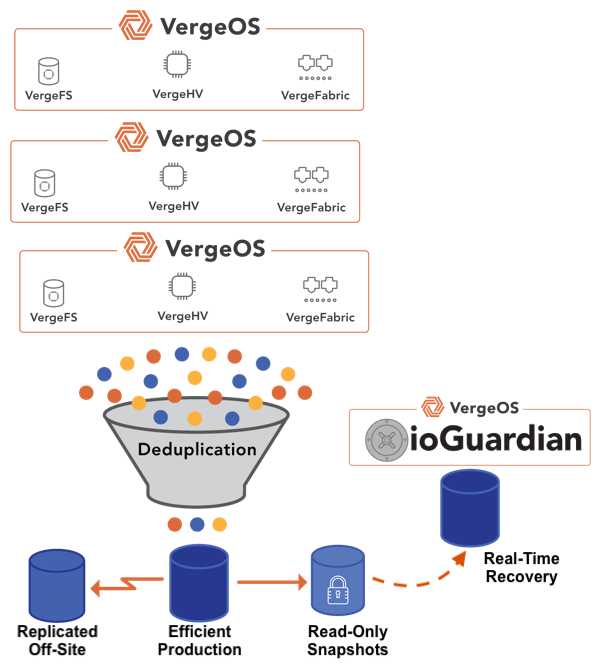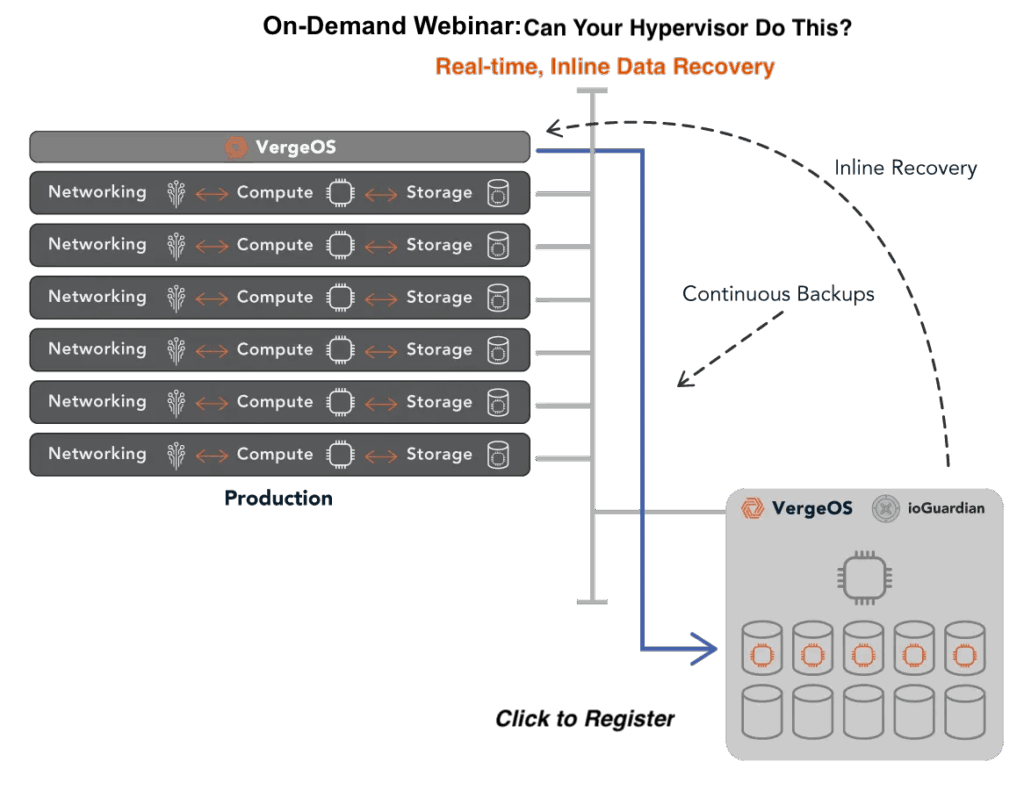
As part of a VMware exit, comparing the VMware alternative storage capabilities is as important as selecting an alternative hypervisor for the organization’s future infrastructure software. Organizations typically examine Nutanix’s Controller Virtual Machine (CVM) architecture against VergeIO’s integrated VergeFS storage within VergeOS. Although both approaches virtualize SAN functionality onto the same servers, creating a virtual SAN (vSAN), the two designs differ. These differences impact resource utilization, operational complexity, stability, and costs.
Understanding vSAN Resource Efficiency
Nutanix employs a storage-as-a-VM architecture using a dedicated CVM running on each node. This CVM consumes substantial resources—between 16GB and 32GB of RAM or more, alongside multiple virtual CPUs (up to 22 vCPUs per node). This significant resource footprint reduces available capacity for production workloads, driving higher infrastructure costs and decreasing resource efficiency, particularly in smaller environments.
VergeIO integrates storage directly into VergeOS via its VergeFS file system, eliminating the need for dedicated controller VMs. This integration ensures more node resources remain available for production workloads, improving resource efficiency without requiring additional hardware investments.
Sizing and Stability of vSAN Alternatives
Sizing complexities are inherent in Nutanix’s CVM-based model. Determining the ideal CVM size is critical yet challenging. Undersized CVMs lead to bottlenecks or instability, while oversized CVMs consume unnecessary resources. Nutanix users sometimes experience stability issues such as random CVM reboots, leading to a reactive response rather than root-cause analysis from support teams.
VergeIO’s integrated storage approach within the OS kernel eliminates these sizing complexities, providing predictable and stable performance without the risk of bottlenecks or instability. This inherent stability reduces operational overhead, making VergeIO a reliable VMware alternative with minimal administrative intervention.
Understanding vSAN: Performance

When under load or insufficiently resourced, Nutanix’s CVMs negatively impact VM performance on the same node, leading to broader performance degradation across the cluster. VergeIO’s integrated approach ensures stable and consistent resource utilization, avoiding disruptions and translating directly into improved cluster reliability and responsiveness.
VergeIO consistently publishes detailed performance benchmarks, demonstrating VergeOS’s real-world capabilities. Nutanix, in contrast, has provided minimal transparency regarding vSAN performance. While no benchmark perfectly represents every customer scenario, VergeIO’s results offer valuable insights.
Recent VergeOS performance benchmarks show impressive outcomes, including over 1.5 million read IOPS, 23 GB/s throughput on a 25 GB/s network, and realistic 64k block sizes at less than one penny per IOPS. Independent testing by StorageReview demonstrated VergeOS handling 1,000 virtual desktops booting in 71 seconds. These benchmarks substantiate VergeIO’s superior performance and transparency claims compared to Nutanix.
Management and Troubleshooting a VMware Alternative
Nutanix’s separate CVM introduces additional management complexity, requiring administrators to monitor, maintain, and troubleshoot an extra software layer. Issues such as CVM reboots or resource contention complicate troubleshooting, increasing operational burdens.
By removing the separate CVM layer, VergeOS simplifies operations. Administrators gain straightforward monitoring, simplified diagnostics, and faster issue resolution, all integrated transparently within VergeOS.
Understanding vSAN Controller Resiliency
A key consideration when comparing the VMware alternative storage capabilities is how the solution handles resiliency. Nutanix promotes its distributed “leader” CVM architecture, allowing any node to assume cluster leadership. However, this approach offers limited practical advantage, as additional leader nodes beyond simultaneous node failure tolerance are redundant. Nutanix clusters configured with RF3 can survive two simultaneous node failures, reducing the practical value of additional leaders.
VergeIO’s ioGuardian provides redundancy and resilience beyond traditional N+2 redundancy. While conventional three-way mirroring (N+2) continuously replicates data across three nodes, ioGuardian enhances protection by maintaining an independent, deduplicated third copy, stored separately from the primary mirrored dataset. This highly available backup replaces traditional backups and becomes integral to your continuous availability strategy.
IoGuardian seamlessly and transparently serves data back to the production environment in real time during multi-node or multi-drive failures, even exceeding two nodes. Affected virtual machines instantly retrieve the necessary data from the ioGuardian storage, eliminating downtime and ensuring uninterrupted operations without manual intervention or complex recovery workflows.
Combining immediate real-time data availability, reduced infrastructure overhead, and simplified management, ioGuardian substantially surpasses the protection and operational simplicity achievable with standard N+2 redundancy approaches.
How a vSAN Impacts TCO
Nutanix’s CVMs impact total cost of ownership (TCO) beyond licensing. They require substantial resources, necessitating larger hardware configurations, increasing capital expenditures, and increasing ongoing licensing expenses.
In contrast, VergeIO’s integrated VergeFS reduces the software footprint, simplifies licensing with straightforward per-server pricing, and optimizes existing or commodity hardware. This approach considerably lowers infrastructure costs, positioning VergeIO as a cost-effective VMware alternative storage solution.
Summary of VergeOS Advantages

Comparing VMware alternative storage capabilities reveals that VergeIO’s integration of VergeFS into VergeOS provides significant practical advantages over Nutanix’s CVM-based storage model. It maximizes resource efficiency, ensures consistent and reliable performance, simplifies management, and reduces infrastructure and licensing costs. These combined advantages position VergeIO as an attractive VMware alternative storage solution, ideal for organizations seeking efficiency, stability, simplicity, and cost-effectiveness.
To further explore VMware alternative data availability and see these considerations in action, join our upcoming VergeIO webinar. Our experts will provide an in-depth comparison of hyperconverged and ultraconverged architectures, highlighting performance benchmarks, operational simplicity, and cost-efficiency. Register now to ensure your infrastructure decisions align with your organization’s strategic priorities.
Our latest white paper, “HCI Data Availability Analysis,” delves into the crucial issue of maintaining availability in Hyperconverged and Ultraconverged architectures by comparing how Nutanix and VergeIO ensure data access during hardware failures.



